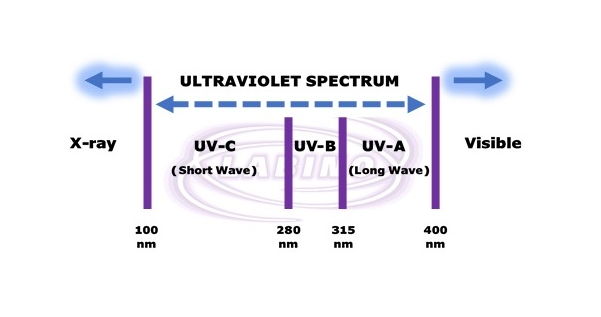How the Ultraviolet (UV) Spectrum is used in nondestructive testing (NDT)
Blog | 05.10.20
Ultraviolet light occurs between the visible and x-ray spectrums. The Ultraviolet wavelength range is specified as 100 nm to 400 nm although you may find definitions exceeding this on the long wave side. Although much of the output of UV light is not visible to the human eye, a violet glare is visible in wavelengths neighboring visible light. UV light for LEDs can be broken down into 3 general areas. These are classified as UV-A, UV-B and UV-C.
Ultraviolet A (UV-A) 400 – 315 nm LED lights have been traditionally used in applications such as Nondestructive Testing (NDT), counterfeit detection or validation (Currency, Driver’s license, Documents), Forensics (Crime scene investigations), UV curing (inks, adhesives), art restoration, to name a few.
Specifically for nondestructive testing (NDT), all fluorescent penetrants and magnetic particle materials fluoresce under UV-A, at 365 nm. This is how the formulations for penetrants and magnetic particle materials were designed to react (fluoresce), at 365 nm wavelength. In Forensics, a number of traces are detected and examined under UV-A, individually, or by adding specialized powders. Labino UV-A portfolio of products consists of GX Orion Stationery UV-A, BB 2.0 Series handheld UV-A, MB 2.0 Series handheld UV-A, UVG3 2.0 UV-A flashlight and UVG5 UV-A headlight.
Ultraviolet B (UV-B) 315 – 280 nm is the least appreciated wavelength within the UV spectrum albeit not entirely neglected. UV curing, biomedical and DNA analysis have some use for UV-B.
Ultraviolet C (UV-C) 280 – 100 nm lights are perhaps the most recognizable ones these days due to COVID-19. They find usage in disinfection as well as air and water purification systems.
There are safety concerns with all categories of UV, although the UV-C is the most harmful, not just to micro-organisms such as bacteria, but also humans. UV in general can cause damage to the eyes and be the cause of skin cancer. Take all precautions and protect yourself against UV exposure.

